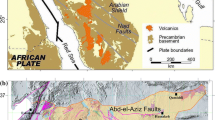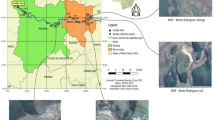Abstract
Radon measurements were made in the soil and spring/seepage water in and around an active landslide located along the Pindar river in the Chamoli District of Uttaranchal in Garhwal Lesser Himalaya, to understand the application of radon in geological disasters. The landslide is a compound slide i.e. a slump in the crown portion, and debris slide and fall in the lower part. The bedrock consists of gneisses and schists of the Saryu Formation of the Almora Group of Precambrian age. The presence of several small slump scars and debris slide/fall scars along the length of the slide indicates continuous downward movement. The radon concentrations in the present study are much lower in comparison to values reported from other regions. However, the present radon data show relative variation in the slide zone. The concentration of radon measured in landslide zones varies from 3.1 Bq/l to 18.4 Bq/l in spring water and from 2.3 kBq/m3 to 12.2 kBq/m3 in the soil gas of the debris. Along the section of the slide, the radon values in water and soil are slightly higher in the upper slopes i.e. toward the crown portion of the landslide as compared to the distal portion. The relatively low concentration of radon both in soil gas and water in the toe portion of the landslide may be due to the high porosity of the debris, which does not allow radon to accumulate in the soil and water, whereas, towards the crown portion, the high frequency of fractures increases the surface area due to particle size reduction, and the near absence of debris enhances the radon emanation in soil.




Similar content being viewed by others
References
Agarwal NC, Kumar G (1973) Geology of upper Bhagirathi and Yamuna valleys, Uttarkashi Distt. Kumaun Himalaya. Him Geol 3:1–23
Ball TK, Cameron DG, Colman TB, Robert PD (1991) Behaviour of radon in the geological environment: a review. Q J Eng Geol Lond 24:169–182
Bartarya SK, Virdi NS, Sah MP (1996) Landslide Hazards: Some case studies from the Satluj valley, Himachal Pradesh. J Him Geol 17:193–207
Choubey VM (1998) Radon measurements in soil and water and its relation with geology, Garhwal Himalaya. In: Katase A, Shimo M (eds) Preceeding volume of 7th Tohwa international symposium “Radon and Thoron in the Human Environment” held at Fukuoka, Japan October 1997. World Scientific Publ, Singapore, pp 193–198
Choubey VM, Bist KS, Saini NK, Ramola RC (1999) Relation between soil-gas radon variation and the different lithotectonic units of Garhwal Himalaya, India. J Appl Radiat Isot 51(5):587–592
Choubey VM, Bartarya SK, Saini NK, Ramola RC (2001) Impact of geohydrology and neotectonic activity on radon concentration in groundwater of intermontane Doon Valley, Outer Himalaya, India. Environ Geol 40(3):257–266
Choubey VM, Bartarya SK, Ramola RC (2004) Radon variations in soil and water in eastern Uttaranchal, Kumaun Himalaya (communicated).
Ennemoser O, Ambach W, Brunner P, Schneider P, Oberaigner W, Purtschller R, Stingl V (1993) Unusually high indoor radon concentrations. Atmos Environ 27A(14):2169–2172
Ennemoser O, Ambach W, Brunner P, Schneider P, Oberaigner W, Purtschller F, Stingl V, Keller G (1994) Unusaly high indoor radon concentrations from a giant rockslide. Sci Total Environ 151:235–240
Gansser A (1964) Geology of the Himalaya. Inter Science Publication. Wiley, New York, p 289
Ghosh PC, Bhalla NS (1981) On the behaviour and measurement of thoron (220Rn) in soil. Ind J Earth Sci 8:1–9
Hess CT, Michel J, Horton TR, Prichard HM, Coniglio WA (1985) The occurrence of radio-activity in public water supplies in the United States. Health Phys 48(5):553–586
Kemsi J, Siehl A, Stegemann R, Valdivia-manchego M (2001) Mapping the geogenic radon potential in Germany. Sci Total Environ 272:217–230
Kies A, Storoni A, Tosheva Z, Hofmann H (2004) Radon measurements as a monitoring possibility for mining subsidence occurrences, Norm IV, Szczyrk, pp 625–632
Pirchl T, Sieder G, Brunner P, Purtschller F, Stingl V, Tessadri R (1994) Geochemische, mineralogische und geologische Aspekte zur Radon-Anomalie in Umhausen/Ötztal. Mitt.Österr. Min Ges 139:360–361, Wien
Purtschller F, Stingl V, Brunner P, Ennemoser O (1994) The Tsergo Ri Landslide (Langtang Himal)—a case study of radon emanation from giant landslides. J Nepal Geol Soc 10:102–104
Purtschller F, Pirchl P, Sieder G, Stingl V, Tessadri T, Brunner P, Ennemoser O, Schneider P (1995) Radon emanation from giant landslides of Koefels (Tyrol, Austria) and Langtang Himal (Nepal). Environ Geol 26:32–38
Ravindran KV and Philip G (2002) Mapping of 29th March 1999 Chamoli earthquake induced landslides using IRS-IC-ID data. Him Geol 23(1&2):69–76
Sah MP and Bartarya SK (2002) The impact of March 29th, 1999 Chamoli earthquake on slope stability and spring discharge in Chamoli and Rudraprayag districts of Garhwal Himalaya. Him Geol 23(1&2):121–133
Saklani PS (1972) Lithostratigraphy and structure of the area between the Bhagirathi and Bhilangana rivers, Garhwal Himalaya. Him Geol 2:342–355
Schery SD, Gaeddert DH, Wilkening MH (1982) Transport of radon from fractured rock. J Geophys Res 87(B4):2969–2976
Semkov TM (1990) Recoil-emanation theory applied to radon release from mineral grain. Geochim. Cosmochim Acta. 54:425–440
Singh M, Singh NP, Singh S and Virk HS (1986) Calibration of radon detectors. Nucl Tracks-Radiat Meas 12:739–742
Surbeck H (1992) Das nationale Schweizer Radonprogramm. In: Tagungsber 14th Jahrestagg. OSRAD, Vienna, pp 6–14
Sutherland DS (1994) Radon workshop- geology, environment, techniques. Geoscientist 4(2):27–29
Valdiya KS (1978) Extension and analague of the Chail nappe in Kumaun. Ind. J Earth Sci 5:1–19
Valdiya KS (1980) Geology of Kumaun Lesser Himalaya. WIHG Publ., Dehra Dun, p 291
Valdiya KS (1998) Catastrophic landslides in Uttaranchal, Central Himalaya. J Geol Soc Ind 52:483–486
Acknowledgements
We are thankful to the Director, Wadia Institute of Himalaya Geology, Dehradun, for providing necessary facilities to carry out the present study. The authors (V.M. Choubey and R.C. Ramola) are also thankful to DST, Government of India, for providing the funds in the form of a research project.
Author information
Authors and Affiliations
Corresponding author
Rights and permissions
About this article
Cite this article
Choubey, V., Bartarya, S. & Ramola, R. Radon variations in an active landslide zone along the Pindar River, in Chamoli District, Garhwal Lesser Himalaya, India. Environ Geol 47, 745–750 (2005). https://doi.org/10.1007/s00254-004-1196-8
Received:
Accepted:
Published:
Issue Date:
DOI: https://doi.org/10.1007/s00254-004-1196-8




